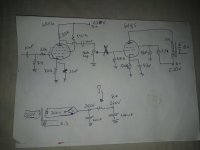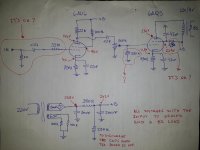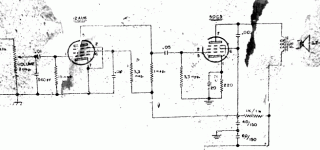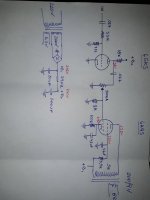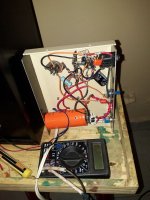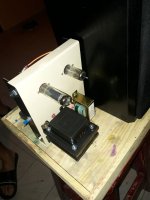Can you help me with de missing values?
Sorry. The missing value of the resistor in the power supply
Attachments
the 6AQ5 should draw about 50 mA in class A single ended operation. The 6AU6 will eat about 3 to 5 mA, so you want to lose 20 volts with 55 mA flowing, that's 363 ohms. Anything from 330 to 390 will probably work. If that's not handy stick in the closest resistor you have and tweak from there. It will burn a bit over 1 watt, so use a 2 watt or bigger resistor.
The common connection in a tube guitar amp puts the opt primary directly on the first filter cap feeding the maximum voltage to the output tube's plate. Everything else gets wired to the second cap. If you try this the load on the dropping resistor will be much less, so a larger resistor will be needed, something in the 2.2 to 4.7K range.
The common connection in a tube guitar amp puts the opt primary directly on the first filter cap feeding the maximum voltage to the output tube's plate. Everything else gets wired to the second cap. If you try this the load on the dropping resistor will be much less, so a larger resistor will be needed, something in the 2.2 to 4.7K range.
A wide range of resistors and results can be used here.
It also affects filtering.
10 Ohms would be very little filtering but a bit louder. If you need "loud in the showroom, cheap in the factory" you would go low.
2K Ohms would give a lot of filtering but a lot less output. However you are not building a 6AQ5 amp to blow-down the stadium. Less output may even be a goal.
Blindfolded, no goal, you can pick this resistor same-as the power tube cathode resistance. No magic theory, just works out. George's over-thinking came to this result.
As George says, the "most" power would take plate transformer from the first cap, all else from 2nd. But the 1st cap has lots of buzz. Amps have been made this way. Usually you add NFB or shrink the speaker so no-lows. Considering the ecology of small SE amps today, taking OT from 2nd cap kills buzz better and is loud enough.
It also affects filtering.
10 Ohms would be very little filtering but a bit louder. If you need "loud in the showroom, cheap in the factory" you would go low.
2K Ohms would give a lot of filtering but a lot less output. However you are not building a 6AQ5 amp to blow-down the stadium. Less output may even be a goal.
Blindfolded, no goal, you can pick this resistor same-as the power tube cathode resistance. No magic theory, just works out. George's over-thinking came to this result.
As George says, the "most" power would take plate transformer from the first cap, all else from 2nd. But the 1st cap has lots of buzz. Amps have been made this way. Usually you add NFB or shrink the speaker so no-lows. Considering the ecology of small SE amps today, taking OT from 2nd cap kills buzz better and is loud enough.
The choice of where to connect the B+ to the OPT has a lot to do with the "tone" of the amp, as do the resistor values around the 6AU6. I could reach the word limit for a single post and not explain it all.....
The short story on the B+. Hanging everything on the second cap could result in less hum. All of the amp's current must flow through the dropping resistor, so the resistor must be relatively small. The B+ voltage will sag somewhat when the amp clips hard, but not that much. Many players prefer this.
Hanging the plate of the output tube on the first cap, and everything else on the second cap allows for a much larger dropping resistor since it only carries 5 to 10 mA.....until the amp hits clipping, then the screen current goes up quickly, dragging its voltage, AND the preamp's B+ down with it. You can play this against some of the resistor values in the first stage to make for some creamy sounding long decaying notes which can be modulated with the guitar's volume knob or playing style. There are many variables, and my amp has 3 stages with a tone control, so it took my about 3 weeks of tweaking with 4 or 5 pots wired into the amp to get right, but I have played that amp for nearly 3 years now, and never had to mess with it.
My amp started out like this one, a 6AU6 driving a 6AQ5, with a 6AV6 and a second 6AQ5 added later. It was a design effort for the Hundred Buck Amp Challenge, and this was a minimum dollar design, so I switched to series heater versions of similar tubes to reduce the cost (and the output power). It has 4 tubes that cost $1 each, with a $16 power transformer and a $5 OPT, yeah it's cheap, well under $50 total.
The short story on the B+. Hanging everything on the second cap could result in less hum. All of the amp's current must flow through the dropping resistor, so the resistor must be relatively small. The B+ voltage will sag somewhat when the amp clips hard, but not that much. Many players prefer this.
Hanging the plate of the output tube on the first cap, and everything else on the second cap allows for a much larger dropping resistor since it only carries 5 to 10 mA.....until the amp hits clipping, then the screen current goes up quickly, dragging its voltage, AND the preamp's B+ down with it. You can play this against some of the resistor values in the first stage to make for some creamy sounding long decaying notes which can be modulated with the guitar's volume knob or playing style. There are many variables, and my amp has 3 stages with a tone control, so it took my about 3 weeks of tweaking with 4 or 5 pots wired into the amp to get right, but I have played that amp for nearly 3 years now, and never had to mess with it.
My amp started out like this one, a 6AU6 driving a 6AQ5, with a 6AV6 and a second 6AQ5 added later. It was a design effort for the Hundred Buck Amp Challenge, and this was a minimum dollar design, so I switched to series heater versions of similar tubes to reduce the cost (and the output power). It has 4 tubes that cost $1 each, with a $16 power transformer and a $5 OPT, yeah it's cheap, well under $50 total.
I stripped an old radio chassis and used it and the sockets as a test bed for a 6AU6 SE amp (don't remember the output tube). I think I had another triode involved, not an important tidbit (think 6AV6) as I was more interested in what I could get out of a 6AU6. I had a pot as the plate resistor, one for the screen resistor and one for the cathode resistor. I wanted to find out if there were any sweet spots in the tube's response that would make it sound better.
Using fixed resistors would have taken a while as well as made it harder to determine which value sounded better. As far as I can remember there were a couple of combinations that sounded best. To make matters worse I wanted to find out what would be the best values for the 6AU6 in triode mode also. It also had a sweet spot, of course not using similar values as in pentode. If I were to play with an input pentode again I would go through the same process as there was a marked difference.
On SE amps I was chasing down some hum, I increased the capacitance at the first stage, then the second. I found I had the most reduction by having increased filtering on the screen supply. This would also have an effect on the amp's dynamics, would be interesting to have pots to twiddle for the output stage. Maybe using Mosfets, one day when I have time.
Using fixed resistors would have taken a while as well as made it harder to determine which value sounded better. As far as I can remember there were a couple of combinations that sounded best. To make matters worse I wanted to find out what would be the best values for the 6AU6 in triode mode also. It also had a sweet spot, of course not using similar values as in pentode. If I were to play with an input pentode again I would go through the same process as there was a marked difference.
On SE amps I was chasing down some hum, I increased the capacitance at the first stage, then the second. I found I had the most reduction by having increased filtering on the screen supply. This would also have an effect on the amp's dynamics, would be interesting to have pots to twiddle for the output stage. Maybe using Mosfets, one day when I have time.
I had the pots wired into the 4 tube amp that I built for the HBAC for quite some time. I would play it and turn knobs until I liked it, then play for a while until I got tired and turn it off. I would return a day or two later and find the urge to turn the knobs some more.
At first I thought that something in the amp was drifting as it got hot, so I left it on for several days, but the pot twiddling continued, so I started marking the knobs.
I began to notice that the same pattern kept repeating. I eventually split the differences and put fixed parts in. Now that I have used the revised version of the amp for a couple of years, I believe that I kept trying to compensate for the drop off in my playing skills as playing time stretched on. My arthritic hands don't go where I want them to any more, and my patience wears thin as pain and cramping set it.
I have several ideas that I want to try, but I'm not messing with this amp. I'll make another one to tweak on, or resurrect the old breadboard and play with it.
Either way.....remember this important tip........
DO NOT TOUCH METAL PARTS ON THE GUITAR WITH ONE HAND WHILE POKING AROUND IN A LIVE AMP WITH THE OTHER HAND!!!! It will lead to temporary loss of vocabulary control! At least two of those pots are connected to B+ and the guitar strings are grounded. My amp only runs at 165 volts, but it will still lead to bad language.
At first I thought that something in the amp was drifting as it got hot, so I left it on for several days, but the pot twiddling continued, so I started marking the knobs.
I began to notice that the same pattern kept repeating. I eventually split the differences and put fixed parts in. Now that I have used the revised version of the amp for a couple of years, I believe that I kept trying to compensate for the drop off in my playing skills as playing time stretched on. My arthritic hands don't go where I want them to any more, and my patience wears thin as pain and cramping set it.
I have several ideas that I want to try, but I'm not messing with this amp. I'll make another one to tweak on, or resurrect the old breadboard and play with it.
Either way.....remember this important tip........
DO NOT TOUCH METAL PARTS ON THE GUITAR WITH ONE HAND WHILE POKING AROUND IN A LIVE AMP WITH THE OTHER HAND!!!! It will lead to temporary loss of vocabulary control! At least two of those pots are connected to B+ and the guitar strings are grounded. My amp only runs at 165 volts, but it will still lead to bad language.
You will have to experiment with the value of the plate load resistor. 22K is too small. I would try something around 100K, then increase the screen grid resistor to bring the plate voltage back up to around 150 volts.
These two resistors and the cathode resistor all interact to set the gain and sound quality of the amp. As I stated earlier I had pots in place of them and turned knobs for several days to get what I wanted.
Raise the 330K question mark resistor to 1 meg, and try a 1 meg volume pot if you have one.
These two resistors and the cathode resistor all interact to set the gain and sound quality of the amp. As I stated earlier I had pots in place of them and turned knobs for several days to get what I wanted.
Raise the 330K question mark resistor to 1 meg, and try a 1 meg volume pot if you have one.
Last edited:
> How can i get more gain from the 6au6?
Datasheet, page 2.
22K is off-the-table, in the direction of low gain.
For the proposed 500K next-stage load (omitting the 330K), G.E. liked 240K-510K plate resistor, gain 240-280. And G.E. tells you some suitable values for RK and RG2, which can be tedious to cut/try find on a pentode.
However anything much over George's 100K will give more gain below 1KHz and less gain beyond 10KHz. For Guitar, Fender did OK with a million 100K resistors; some other brands did higher values. I would not go over 250K for plate resistor unless I was willing to shave the highs.
You do understand that two stages makes a LOT more gain than any one stage hot-rodded? One 6AU6 = 160-"350", both halves of 12AX7 = 2,500.
Datasheet, page 2.
22K is off-the-table, in the direction of low gain.
For the proposed 500K next-stage load (omitting the 330K), G.E. liked 240K-510K plate resistor, gain 240-280. And G.E. tells you some suitable values for RK and RG2, which can be tedious to cut/try find on a pentode.
However anything much over George's 100K will give more gain below 1KHz and less gain beyond 10KHz. For Guitar, Fender did OK with a million 100K resistors; some other brands did higher values. I would not go over 250K for plate resistor unless I was willing to shave the highs.
You do understand that two stages makes a LOT more gain than any one stage hot-rodded? One 6AU6 = 160-"350", both halves of 12AX7 = 2,500.
Here is a "high gain" plan from a $9.95 "guitar amp". This was the absolute bottom of the barrel, then and now (it would not be legal today and I have omitted that part). It was probably sold on a 30-day warranty which did not cover tubes. Note that the power tube grid resistor is far past rated max- as soon as the 50C5 gets a little gassy it will burn-up. For more fun, the "cabinet" is actual cardboard (heavy shoe-box) and everything is about as cheap as it gets. Brand of this particular sample (now in my garage) is "Kent" but this may be the low-price brand for "Kay" (known for cheap amps).
Attachments
> it would be fantastic!
For some definition of "fantastic".
FWIW, although mine must be over 50 years old it shows zero sign of use. I bet it was a birthday gift, the kid played two chords and then went looking for a "real" amplifier. Note that it is "less" than Fender's first Champ, and Leo quickly moved on to the 12AX7 Champ.
For some definition of "fantastic".
FWIW, although mine must be over 50 years old it shows zero sign of use. I bet it was a birthday gift, the kid played two chords and then went looking for a "real" amplifier. Note that it is "less" than Fender's first Champ, and Leo quickly moved on to the 12AX7 Champ.
I found a Kent guitar amp in an antique store near here several years ago. It had 3 or 4 tubes and used a bit more modern circuit. I did put an isolation transformer in it, but the speaker cone came apart the first time I cranked on it so I gave it away.
The schematic shown here uses grid leak bias in the input stage like the original Fender 5C1 it was copied from with some serious cost reduction applied.....this thing had to be made by Muntz!
The first guitar amps I made were 5C1 clones with any output tube from a 6V6 (hard to find in the trash) to a 6K6 to a 6BQ6 (real common). The grid leak bias might have been almost OK with the old wimpy single coil pickups of the day, but hit one hard with a fuzz pedal turned up all the way and you can make blocking distortion in the input stage.
After fixing that, it had enough gain to hit clipping with my crappy Lafayette Radio Electronics guitar of the day (about 1960).
As I stated earlier, get it all working, then stick another gain stage in with that high Mu tuner triode on your list.....then you will be ahead of the 12AX7 guys.
The schematic shown here uses grid leak bias in the input stage like the original Fender 5C1 it was copied from with some serious cost reduction applied.....this thing had to be made by Muntz!
The first guitar amps I made were 5C1 clones with any output tube from a 6V6 (hard to find in the trash) to a 6K6 to a 6BQ6 (real common). The grid leak bias might have been almost OK with the old wimpy single coil pickups of the day, but hit one hard with a fuzz pedal turned up all the way and you can make blocking distortion in the input stage.
After fixing that, it had enough gain to hit clipping with my crappy Lafayette Radio Electronics guitar of the day (about 1960).
As I stated earlier, get it all working, then stick another gain stage in with that high Mu tuner triode on your list.....then you will be ahead of the 12AX7 guys.
thank to everyone for their answers and their help with the theory.
At the end I tried the 6gk5 tube in the pre and the final result was great. I leave you the circuit with the values i used and the tensions. According to my calculations in the tube 6aq5 I have a plate dissipation of 11w approx.
At the end I tried the 6gk5 tube in the pre and the final result was great. I leave you the circuit with the values i used and the tensions. According to my calculations in the tube 6aq5 I have a plate dissipation of 11w approx.
Attachments
Last edited:
- Status
- This old topic is closed. If you want to reopen this topic, contact a moderator using the "Report Post" button.
- Home
- Live Sound
- Instruments and Amps
- Best combination for a guitar tube amp!
